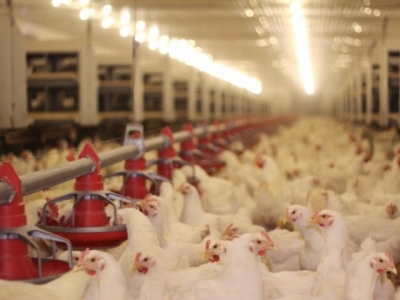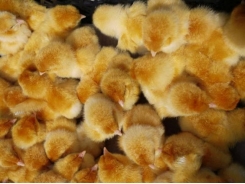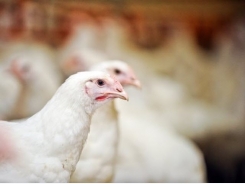Great layer performance starts in the pullet house

The management provided to a flock before the start of lay can mean the difference of 10 or more eggs per hen through 80 weeks.
Each generation of layer chicks arrives on the farm with the genetic potential to outperform the previous generation. Dr. Ian Rubinoff, technical services veterinarian, Hy-Line International, told the audience at the Midwest Poultry Federation Convention Pullet/Layer Health Workshop that it is the interaction of the environment, management, health, and nutrition, and their interaction with the genomes of the pullets, which set the stage for later productivity in the layer house. “Pullet development is the key to layer success,” he said. “A major portion of genetic potential is determined before that bird is 20 weeks old.”
Rubinoff stated that the pullet rearing period can be broken into three phases, 0-6, 7-12 and 13-18 weeks of age. He said that doing an exceptional job in the pullet house versus a less than perfect job can make the difference of 10 eggs per hen to 80 weeks of age, which is the difference between an average flock and one performing at optimum.
Getting started: 0-6 weeks
Cleaning pullet houses is more important than ever, according to Rubinoff, because of the U.S. Food and Drug Administration’s Egg Safety Rule. He said that the more you clean and disinfect, the better. After cleaning, make sure you close up holes in the house to exclude rodents, and put your bait stations and traps back out.
Clean, disinfect and flush the water lines and the drinkers as part of your house cleanup. Remember to flush the water lines again before you get birds. He said that you want cup drinkers level with the chicks back and you want to fill them manually for the first three days. You want the nipple drinker level with the chicks head.
Clean chick paper should be used in the entire cage to make it easier for the chicks to get around in the cage the first few days. Rubinoff said that you want to put feed on the paper in the front third of the cage so that when chicks eat feed off the chick paper they are near the feed trough and get used to eating in the front of the cage.
Rubinoff said that some producers make the mistake of not heating houses up a day or two before birds arrive. “You need to heat your house up early enough not just to heat the air, but to heat up the concrete and the cages,” he said.
Many pullet growers start their birds on 22 or 23 hours of light, according to Rubinoff. He said that Hy-Line recommends intermittent lighting programs, which give the young pullet a regular pattern of rest and activity.
Chicks are precocial, but there is still a lot of growth and development necessary after the chick has hatched. The intestinal tract, the immune system, and the integument (skin and feathers) undergo a lot of growth and development in the first six weeks after hatch.
Monitoring body weights is a critical part of raising pullets. Rubinoff said to start weighing birds at three to four weeks of age, and to weigh them weekly thereafter. He said to weigh at least a hundred birds from marked cages. They should be weighed from cages from different tiers, front and back, and on both sides.
The growth spurt: 7-12 weeks
The primary focus of the second six weeks of pullet rearing should be on reaching target body weight, according to Rubinoff. Now that pullets have a more mature intestinal tract, immune system, and are able to thermo regulate, more energy can be put into growth.
Pullets that have higher levels of stress during the growth spurt are more likely to have poor uniformity, which can negatively affect peak production. When flocks lack uniformity, the birds on the low end of the body weight scale will not come into production until five to 10 weeks after other birds. While most of the flock may be laying 96 percent, the 5 percent of the flock that is laying sporadically, or not at all, will pull the peak down. Stressors that can be avoided include moving, injecting with killed vaccine, widely fluctuating environmental conditions inside the house, poor feed quality, crowding, and any other abrupt changes in routine. Stress can affect a flock at any time; however, this period is most critical as birds can gain up to 100 grams a week, so any insult to growth will have a great effect. Rubinoff said that using a killed Salmonella enteritidis bacterin during the growth spurt can set a bird back around 50 grams of weight.
Laying hens have three types of bone: cortical, trabecular, and medullary. During the growth spurt, the cortical (outer structural shell) and trabecular (inner for strength and support) bone are forming. The skeleton is 95 percent developed by 12 weeks of age, and once the bone growth plates close, no more length can be added. Any lag in growth during the growth spurt will affect the size of the mature bird and delay the onset of production. Rubinoff said that body weight at 12 weeks of age will determine how well the hen can regulate calcium.
The transition: 13-18 weeks
Thirteen week old pullets that are on target will have reached about 95 percent of their size, but only 75 percent of their mature weight. Over the next 6 weeks leading up to the start of lay, muscle, medullary bone, and reproductive tract development will constitute much of the weight gain. Once birds have fully developed, the flock will be ready for light stimulation to start production.
Good muscle development is critical for producing a good layer. Muscles are the main store of glycogen, which is the instant energy hens use for producing eggs. If hens have a poor muscle mass, efficiency during production will decrease.
Medullary bone is a vital extra calcium source that allows hens to put two or more grams of calcium into an egg shell day in and day out. Medullary bone starts to form inside the cortical bones, especially in the legs, 10 to 14 days before the start of production. Birds with good skeletal structure will have more room to deposit medullary bone and be less prone to soft bone issues or cage layer fatigue.
Hens hatch with two ovaries and two oviducts, however as sexual maturity progresses, only the left ovary and oviduct develop. The developed ovary has thousands of eggs, but a typical layer will only have several hundred develop into mature ova. The oviduct will mature from a thin strand of tissue, into an organ capable of adding albumin, membranes, shell, and color over the 10 to 14 days before production.
Midnight feeding programs can used to help birds maintain the desired rate of weight gain, particularly in hot weather, according to Rubinoff. Midnight feeding can be instituted as soon as the birds have at least seven hours of darkness, and it should only last one hour and it should be preceded and followed by at least three hours of darkness. Midnight feeding programs need to be removed gradually, not all at once, and should be continued in the layer house if used in the pullet house.
Rubinoff said to feed to target body weights. Do not move to the next phase of the feeding program until the recommended body weights have been reached. This ensures that pullets that are behind in body weight have the best possible nutrition to catch up quickly.
Body weight is the best way to determine if all systems are sufficiently developed. Waiting to light stimulate until target weights are met is the most effective solution to ensure good persistency and avoid a post-peak dip.
Có thể bạn quan tâm
Phần mềm

Phối trộn thức ăn chăn nuôi

Pha dung dịch thủy canh

Định mức cho tôm ăn

Phối trộn phân bón NPK

Xác định tỷ lệ tôm sống

Chuyển đổi đơn vị phân bón

Xác định công suất sục khí

Chuyển đổi đơn vị tôm

Tính diện tích nhà kính

Tính thể tích ao hồ




 8 broiler feed tips to select the right…
8 broiler feed tips to select the right…  Bone selection matters in broiler ash measurement
Bone selection matters in broiler ash measurement